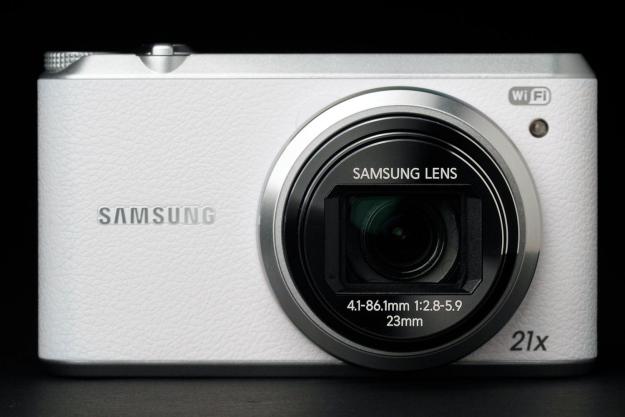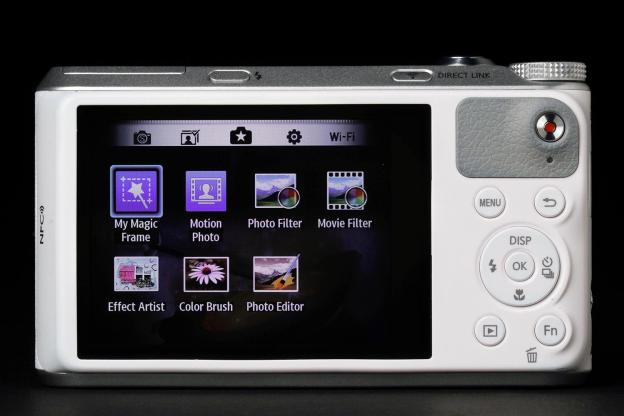
“Judged on image quality, the Samsung WB350F isn’t the best. But throw in a 21x zoom, excellent Wi-Fi, and simple operation, and you get something unique.”
- Excellent Wi-Fi
- Advanced shooting modes
- Responsive touchscreen navigation
- Long lens in a compact design
- Noisy images
- Edges aren’t as sharp
- Startup could be faster
- Prone to discoloration easily
Although point-and-shoot pocket camera sales are on the decline, manufacturers are finding that consumers are gravitating to cameras that are more advanced and incorporate unique feature, with a long zoom being one of them. The Samsung WB350F is one of the company’s latest, and at $260 it’s one of the more affordable options to have a long, wide-angle 21x lens in a compact form factor. The camera also offers advanced shooting options and an excellent Wi-Fi implementation. Image quality is generally good, however there are hiccups. Is having a long lens enough to sway you back to a point-and-shoot camera?
Features and design
The Samsung WB350F’s star feature is its 21x optical zoom lens, with optical image stabilization. The 23mm wide-angle lens (35mm equivalent) has an f/2.8-5.9 aperture and a shutter speed of 16-1/2,000th of a second, depending on the mode. The camera uses a 16.3-megapixel back-illuminated CMOS sensor, but at 1/2.3 inches it isn’t very large. The ISO ranges of 80 to 3,200, there’s a continuous burst mode of 7.1 frames per second, and video capture is up to Full HD 1920 x 1080 at 30 frames per second.
The WB350F isn’t complicated to use, and should be fairly intuitive for most users.
One thing we noticed immediately, to our shock, is how easy it is for the front surface to become discolored. It picked up some of the blue from our jeans pocket, and while we were able to quickly wipe it off, this is a camera that’s best kept in a case.
The camera isn’t overly large, but it isn’t super compact like the many small and slim point-and-shoot models. It’s actually fairly chunky and, at 7.62 ounces, it is hefty and you can feel that in your hand. But much of that is due to the 21x lens, and it isn’t that different from other long-zoom compact cameras.
The WB350F is a fairly simple camera, not unlike most digital cameras. The front is uncluttered with the exception of the large lens barrel that retracts inside and an AF-assist/timer lamp. With the back facing you, there’s an NFC tag on the left (for pairing with an NFC-enabled smartphone or other device), and on the right is a USB and A/V port behind a small door and a slot to attach a wrist strap. At the bottom is the tripod mount, mono speaker, and battery/Micro SD card compartment. Samsung uses Micro SD for many of its cameras, and, depending on the user, it’s a “love it or hate it” issue. Some of us on staff like using full-size SD cards because it makes transferring images to a computer easier and quicker, and find smaller Micro SD cards difficult to handle; others didn’t see a problem.
On the top of the camera you’ll find the mode dial, power button, shutter button, zoom toggle (surrounding the shutter button), mode dial, mono microphone, flash button to pop the flash out (it’s a hinged design as opposed to a pop-up or embedded flash, so flash images look less harsh), and a Direct Link button to access a preset Wi-Fi function.
For sharing or printing images at small or medium sizes, the WB350F does a good job.
The WB350F is more advanced than your basic point-and-shoot, so there are more shooting modes to choose from, accessible through the mode dial. There’s auto, program, ASM (aperture priority, shutter priority, and manual), Smart Mode (which is the preset scene modes for shooting in conditions like sunset, low light, macro, and fireworks, as well as photo effects like panoramas and light trails), Best Face (as the name suggests, a burst mode for portraits that takes multiple shots, allowing you to pick the one you like best), and a mode that lets you edit or add effects to photos. The mode dial is also where you access the system settings and Wi-Fi menus.
As mentioned, once you’re in one of the modes, you’ll make most of your adjustments through the touchscreen; you can touch to focus, call up the Function menu to adjust settings like white balance and aperture, or navigate through menus. You can also use the physical buttons, but Samsung made the menus relatively easy to understand and use via the touchscreen. It’s not the newer camera user interface that Samsung employs in its Galaxy and NX cameras, but it’s relatively straightforward. For those new to more advanced functions, there are helpful boxes that pop up, telling what a particular function does or what a feature is for. Despite the available ASM shooting modes, the WB350F is really best as an automatic camera, but the more advanced shooting modes are there should you want to exercise some user control.

Most new Samsung cameras offer Wi-Fi connectivity, and Samsung does a better job than most when it comes to this feature. You can share a photo or video directly to Facebook, Picasa, Dropbox, YouTube, or Samsung Link, or send it via e-mail. You can also transfer images to a smartphone via the MobileLink app for iOS and Android, or control the camera remotely. There’s also an Auto Backup function for saving content to a PC; AutoShare for instant backup of images as they are taken; and a Baby Monitor feature function for using the camera to stream a live video to a
What’s in the box
Samsung doesn’t include much with the camera. You get an AC adapter, USB cable, rechargeable lithium-ion battery, wrist strap, and quick-start guide. The battery charges in-camera, so there’s no battery charger necessary (it’s optional if you want one). Because the WB350F uses Micro SD memory cards, you’ll need an adapter in order to read off the card directly.
Performance and use
The WB350F isn’t complicated to use, and for anybody who’s ever used a digital point-and-shoot camera it should be fairly intuitive. Turn the dial to your preferred shooting mode, and snap away. Want to change the settings? Hitting the Fn button will pull up various options, which you can adjust by tapping on the touchscreen (what those options are will depend on the mode you’re in; you’ll have more settings available if you’re using the PASM modes, for example). If you’re shooting in automatic or one of the scene modes, there isn’t a lot you need to play with. In the more advanced modes, you can make adjustments to things like exposure compensation, ISO, white balance, etc., but since the camera brings them all to the front when you hit the Fn button, there are no seemingly endless menus you have to drill through – plus, you can easily adjust them quickly, thanks to the touchscreen. You can also enable manual focusing, using an onscreen slider instead of focusing ring.
This camera is really designed with point-and-shoot in mind, but more advanced shooting options are available.
The WB350F isn’t the fastest camera we’ve played with, but for its intended user the camera speed is more than acceptable. Autofocusing is very good and has no issues with locking onto objects, but, again, is not the fastest we’ve seen. Face detection is effective as long as the subject isn’t too far away. In one or two occasions the camera froze up, but it’s something we’ve seen before and nothing that can’t be fixed by popping out the battery.
Having a 21x optical zoom can come in handy, and it’s also a fairly wide lens. We were able to zoom all the way to a water tower at the top of a tall building from a far, and capture a nice shot, although at that zoom level you’ll notice that images aren’t as sharp if you’re hand-holding the camera.
For sharing or printing images at small or medium sizes, the WB350F does a good job. Images generally look good at smaller sizes, with good color reproduction. It’s only when you blow it up to their super large, actual sizes that you’ll notice that edges aren’t as sharp. The camera also seems to shoot on the darker side, so you may need to increase the exposure compensation a notch (you’ll have to get out of the auto mode and into at least program mode to do this). The camera also suffers from noise, particularly in low-light shooting, even at lower ISOs, and bright lights at night tend to be overexposed if you’re using the simple auto mode. We will say that our images shot at night weren’t completely unusable, so it’s not all bad news.
The WB350F records video in the MP4 format. If you use a tripod or keep the camera really steady, it’s capable of capturing very nice-looking footage. Having a 21x zoom is handy: We were able to get close to the new One World Trade Center building in Lower Manhattan from our position in Midtown. As it zooms in and out, the camera is a bit slow in refocusing, but it does its best, as quickly as possible. Overall, video quality is smooth so long you brace yourself against something to keep the camera stable; the optical image stabilization wasn’t able to compensate entirely from our hand shakes. Audio capture is so-so, typical for a compact camera.
A positive is the Wi-Fi implementation, which Samsung just nails – what do you expect from a company that’s a leader in smartphones? Pairing the camera to a smartphone is straightforward. It takes a few steps to get started, but we generally didn’t have major issues. We also used the camera with an NFC-enabled Sony Xperia Z1s, and pairing is even smoother and faster, automatically pointing us to apps that we needed. We successfully enabled live streaming (baby monitor) with the Z1s without a hitch, although both devices have to be on the same network, so you can’t tap into the stream from outside. Samsung makes it easy to upload content directly to popular social networking sites, although it would be great to see support for Instagram in the future. We said this already, but we wish Samsung placed all the
Conclusion
For the price, the WB350F is a good camera coupled with a terrific long lens, easy-to-use operation, and excellent Wi-Fi. While it may not be as thin as many slim compact cameras, it’s not bad considering that a 21x optical zoom lens is packed inside it. Autofocusing is good and performance speed is fine, even though it isn’t the fastest camera you can find. Image quality is generally good, especially if you are using them in small to medium sizes, but they aren’t as sharp when viewed in larger sizes and suffer from noise in low-light situations. It’s not a perfect camera, but if you are looking for a compact with a long lens, and at a good price, the WB350F is a good consideration.
Highs
- Excellent Wi-Fi
- Advanced shooting modes
- Responsive touchscreen navigation
- Long lens in a compact design
Lows
- Noisy images
- Edges aren’t as sharp
- Startup could be faster
- Prone to discoloration easily
Editors' Recommendations
- Insta360 cameras take a speedy ride around Monaco’s F1 track
- 10 ways to get the most from Samsung Galaxy S20 and S20 Plus’s camera
- 7 cameras that revolutionized photography and changed how we take pictures










